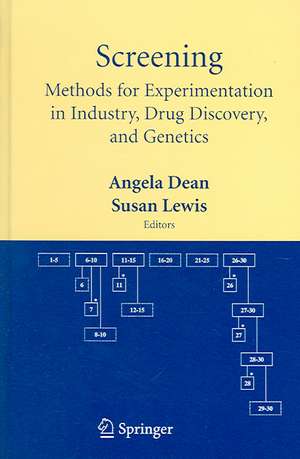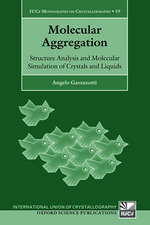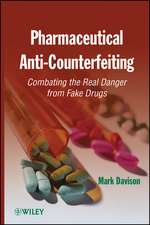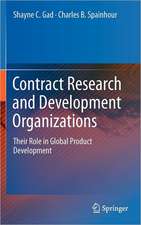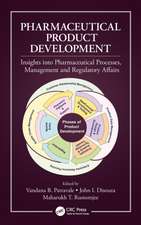Screening: Methods for Experimentation in Industry, Drug Discovery, and Genetics
Editat de Angela Dean, Susan Lewisen Limba Engleză Hardback – 16 feb 2006
This book brings together accounts by leading international experts that are essential reading for those working in fields such as industrial quality improvement, engineering research and development, genetic and medical screening, drug discovery, and computer simulation of manufacturing systems or economic models. Our aim is to promote cross-fertilization of ideas and methods through detailed explanations, a variety of examples and extensive references.
Topics cover both physical and computer simulated experiments. They include screening methods for detecting factors that affect the value of a response or its variability, and for choosing between various different response models. Screening for disease in blood samples, for genes linked to a disease and for new compounds in the search for effective drugs are also described. Statistical techniques include Bayesian and frequentist methods of data analysis, algorithmic methods for both the design and analysis of experiments, and the construction of fractional factorial designs and orthogonal arrays.
The material is accessible to graduate and research statisticians, and to engineers and chemists with a working knowledge of statistical ideas and techniques. It will be of interest to practitioners and researchers who wish to learn about useful methodologies from within their own area as well as methodologies that can be translated from one area to another.
| Toate formatele și edițiile | Preț | Express |
|---|---|---|
| Paperback (1) | 643.00 lei 6-8 săpt. | |
| Springer – 18 oct 2010 | 643.00 lei 6-8 săpt. | |
| Hardback (1) | 648.05 lei 6-8 săpt. | |
| Springer – 16 feb 2006 | 648.05 lei 6-8 săpt. |
Preț: 648.05 lei
Preț vechi: 762.42 lei
-15% Nou
Puncte Express: 972
Preț estimativ în valută:
124.00€ • 129.82$ • 102.61£
124.00€ • 129.82$ • 102.61£
Carte tipărită la comandă
Livrare economică 05-19 aprilie
Preluare comenzi: 021 569.72.76
Specificații
ISBN-13: 9780387280134
ISBN-10: 0387280138
Pagini: 332
Ilustrații: XVI, 332 p.
Dimensiuni: 155 x 235 x 22 mm
Greutate: 0.63 kg
Ediția:2006
Editura: Springer
Colecția Springer
Locul publicării:New York, NY, United States
ISBN-10: 0387280138
Pagini: 332
Ilustrații: XVI, 332 p.
Dimensiuni: 155 x 235 x 22 mm
Greutate: 0.63 kg
Ediția:2006
Editura: Springer
Colecția Springer
Locul publicării:New York, NY, United States
Public țintă
ResearchCuprins
An Overview of Industrial Screening Experiments.- Screening Experiments for Dispersion Effects.- Pooling Experiments for Blood Screening and Drug Discovery.- Pharmaceutical Drug Discovery: Designing the Blockbuster Drug.- Design and Analysis of Screening Experiments with Microarrays.- Screening for Differential Gene Expressions from Microarray Data.- Projection Properties of Factorial Designs for Factor Screening.- Factor Screening via Supersaturated Designs.- An Overview of Group Factor Screening.- Screening Designs for Model Selection.- Prior Distributions for Bayesian Analysis of Screening Experiments.- Analysis of Orthogonal Saturated Designs.- Screening for the Important Factors in Large Discrete-Event Simulation Models: Sequential Bifurcation and Its Applications.- Screening the Input Variables to a Computer Model Via Analysis of Variance and Visualization.
Recenzii
From the reviews:
"This is an excellent aggregation of fourteen papers about screening, covering general areas. It includes recent work and provides first class summaries of various topics. The fourteen chapters have about twenty-two pages of references between them, helping the reader to delve further as needed. It is definitely an excellent library selection … ." (N. R. Draper, Short Book Reviews, Vol. 26 (2), 2006)
"The book provides a comprehensive and accessible overview of historical and modern screening approaches, including design generation strategies, analysis methods, visualization techniques, and gives many examples to illustrate the theory developed. ...The book is an important summary of the work of key researchers in this area and will be a valuable addition to the reference shelf of practioners and researchers alike." (Christine M. Anderson-Cook, Journal of the American Statistical Association, Vol. 102, No. 477, 2007)
"Due to the nontechnical nautre of most of the chapters, this book is a great place for interested readers to start learning about the subject of screening experiments. Each chapter is concluded with a listing of references, so that finding follow-up reading is easy. I can genuinely recommend this book to statisticians of all levels and to numerically minded practitioners. I would especially suggest the book to any graduate student embarking on a research program on some topic related to screening experiments." (Editor, Biometrics, December 2006)
"This is an excellent aggregation of fourteen papers about screening, covering general areas. It includes recent work and provides first class summaries of various topics. The fourteen chapters have about twenty-two pages of references between them, helping the reader to delve further as needed. It is definitely an excellent library selection … ." (N. R. Draper, Short Book Reviews, Vol. 26 (2), 2006)
"The book provides a comprehensive and accessible overview of historical and modern screening approaches, including design generation strategies, analysis methods, visualization techniques, and gives many examples to illustrate the theory developed. ...The book is an important summary of the work of key researchers in this area and will be a valuable addition to the reference shelf of practioners and researchers alike." (Christine M. Anderson-Cook, Journal of the American Statistical Association, Vol. 102, No. 477, 2007)
"Due to the nontechnical nautre of most of the chapters, this book is a great place for interested readers to start learning about the subject of screening experiments. Each chapter is concluded with a listing of references, so that finding follow-up reading is easy. I can genuinely recommend this book to statisticians of all levels and to numerically minded practitioners. I would especially suggest the book to any graduate student embarking on a research program on some topic related to screening experiments." (Editor, Biometrics, December 2006)
Textul de pe ultima copertă
The process of discovery in science and technology may require investigation of a large number of features, such as factors, genes or molecules. In Screening, statistically designed experiments and analyses of the resulting data sets are used to identify efficiently the few features that determine key properties of the system under study.
This book brings together accounts by leading international experts that are essential reading for those working in fields such as industrial quality improvement, engineering research and development, genetic and medical screening, drug discovery, and computer simulation of manufacturing systems or economic models. Our aim is to promote cross-fertilization of ideas and methods through detailed explanations, a variety of examples and extensive references.
Topics cover both physical and computer simulated experiments. They include screening methods for detecting factors that affect the value of a response or its variability, and for choosing between various different response models. Screening for disease in blood samples, for genes linked to a disease and for new compounds in the search for effective drugs are also described. Statistical techniques include Bayesian and frequentist methods of data analysis, algorithmic methods for both the design and analysis of experiments, and the construction of fractional factorial designs and orthogonal arrays.
The material is accessible to graduate and research statisticians, and to engineers and chemists with a working knowledge of statistical ideas and techniques. It will be of interest to practitioners and researchers who wish to learn about useful methodologies from within their own area as well as methodologies that can be translated from one area to another.
Angela Dean is Professor of Statistics at The Ohio State University, USA. She is a Fellow of the American Statistical Association, the Institute of MathematicalStatistics, and an elected member of the International Statistical Institute. Her research focuses on the construction of efficient designs for factorial experiments in industry and marketing. She is co-author of the textbook Design and Analysis of Experiments and has served on the editorial boards of the Journal of the Royal Statistical Society and Technometrics.
Susan Lewis is a Professor of Statistics at the University of Southampton, UK, and Deputy Director of the Southampton Statistical Sciences Research Institute. She has research interests in screening, design algorithms and the design and analysis of experiments in industry. She was awarded the Greenfield Industrial Medal by the Royal Statistical Society in 2005. She has served the Society as a Vice-President and a Member of Council, as well as a former Editor of the Journal of the Royal Statistical Society, Series C (Applied Statistics).
This book brings together accounts by leading international experts that are essential reading for those working in fields such as industrial quality improvement, engineering research and development, genetic and medical screening, drug discovery, and computer simulation of manufacturing systems or economic models. Our aim is to promote cross-fertilization of ideas and methods through detailed explanations, a variety of examples and extensive references.
Topics cover both physical and computer simulated experiments. They include screening methods for detecting factors that affect the value of a response or its variability, and for choosing between various different response models. Screening for disease in blood samples, for genes linked to a disease and for new compounds in the search for effective drugs are also described. Statistical techniques include Bayesian and frequentist methods of data analysis, algorithmic methods for both the design and analysis of experiments, and the construction of fractional factorial designs and orthogonal arrays.
The material is accessible to graduate and research statisticians, and to engineers and chemists with a working knowledge of statistical ideas and techniques. It will be of interest to practitioners and researchers who wish to learn about useful methodologies from within their own area as well as methodologies that can be translated from one area to another.
Angela Dean is Professor of Statistics at The Ohio State University, USA. She is a Fellow of the American Statistical Association, the Institute of MathematicalStatistics, and an elected member of the International Statistical Institute. Her research focuses on the construction of efficient designs for factorial experiments in industry and marketing. She is co-author of the textbook Design and Analysis of Experiments and has served on the editorial boards of the Journal of the Royal Statistical Society and Technometrics.
Susan Lewis is a Professor of Statistics at the University of Southampton, UK, and Deputy Director of the Southampton Statistical Sciences Research Institute. She has research interests in screening, design algorithms and the design and analysis of experiments in industry. She was awarded the Greenfield Industrial Medal by the Royal Statistical Society in 2005. She has served the Society as a Vice-President and a Member of Council, as well as a former Editor of the Journal of the Royal Statistical Society, Series C (Applied Statistics).
Caracteristici
Many important researchers in this field contributed articles to this book
